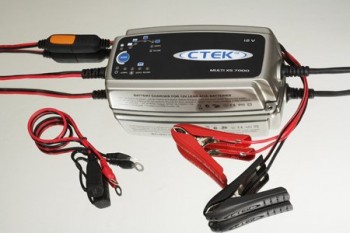
Deep cycle batteries are energy-efficient, environmentally friendly and retain charge for long hours. The design pattern and the construction of deep cycle batteries are the two vital parameters in choosing the right type of charger for the battery.
There are some popular types of these batteries each one having certain distinctive features and therefore, a single battery charger will not suit all varieties of deep cycle batteries. It is thus essential to know about the design of the deep cycle battery before purchasing a charger.
There are four normal types of deep cycle batteries such as wet cell, gel cell, absorbed glass mat and the valve regulated lead-acid (VRLA) type deep cycle batteries. Out of these four, the wet cell deep cycle battery is well-known to most of the people. This variety is similar to an automotive battery and consists of a liquid electrolyte that fills up the partitions or cells inside the battery in which lead plates are suspended.
This most common type of deep cycle battery can be easily purchased from any sports goods shop and the main departmental shops. The design of absorbed glass mat (AGM) deep cycle battery consists of a mesh made from natural fiber to suck up the electrolyte and maintain a steady contact with the lead compound.
It is a sealed device and does not require any maintenance as compared with wet-cell type batteries. In all other respects, the absorbed glass mat type of deep cycle batteries are similar to the wet-cell type and the same type of charger is useful for both.
The VRLA is also a sealed type of deep cycle battery and the main difference between this type and other varieties is that VRLA type deep cycle battery utilizes internal valve to let out the gases accumulated during the charging cycle. The battery charger for wet- cell type is also useful for the valve regulated lead-acid deep cycle battery.
A multiple level battery charger is useful for three types of deep cycle batteries such as the wet-cell, the absorbed glass mat and the VRLA varieties. This type of charger is available in several sizes and it is therefore necessary to choose a charger that corresponds to the particular size of the deep cycle battery.
If one has more number of deep cycle batteries installed in the electrical system, it is necessary to have a ‘multiple bank type’ battery charger, which consists of either one, two, three or even four chargers incorporated into a single unit. Again on the basis of the country in which one resides, it is essential to adjust the input voltage of the charger to the appropriate voltage of the electricity supply of that country.
A number of essential types of chargers are readily available to those interested in buying an inexpensive battery charger. These low-priced chargers are manually operated and consist of only very few special characteristics. In this type of manual chargers, one is required to start and stop the devise manually and disconnect from the socket when not in use.
In this type, one has to manually adjust the dials and the switches located on the front panel every time the battery charger is run and also whenever a new battery is set up for charging. On the other hand, those interested in purchasing a superior battery charger should opt for a ‘smart charger’.
The smart charger is basically a computer monitored device that records readings from the battery to which it is connected and based on the readings, transmits the correct charging voltages and electric current in order to charge the deep cycle battery completely.
Most of the smart chargers also have an equalizer charge incorporated in the system that gets activated after the principal charging is complete This equalizing procedure balances the charges in the individual battery cells. The fourth type of deep cycle battery, the ‘gel-cell’ type is called a deep cycle battery as it can function for long cycles and therefore, requires longer time for charging.
The electrolyte inside the gel cell battery is blended with a thickening substance to solidify the solution. Most people prefer a ‘smart charger’ for charging the gel cell type deep cycle battery mainly because gel cell type is likely to get damaged if overcharged or not correctly charged.
However, this type of battery can withstand higher surrounding temperatures than a wet-cell battery and can retain the charge for longer hours than the other types of batteries. However, it needs specific type of equipment to maintain properly.
A high-quality battery charger eliminates the need to estimate the duration of charging a deep cycle battery. Whether one uses a cheaper version of charger or more advanced smart charger, it is important to comply with a stringent battery maintenance schedule in order to ensure years of hassle-free working life from a ’trolling motor battery’ and other varieties of deep cycle batteries.
